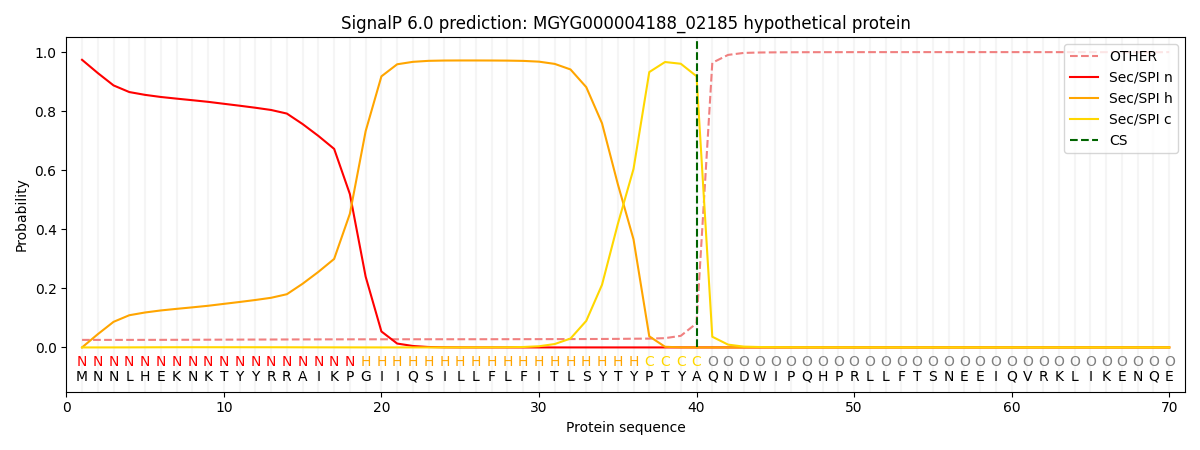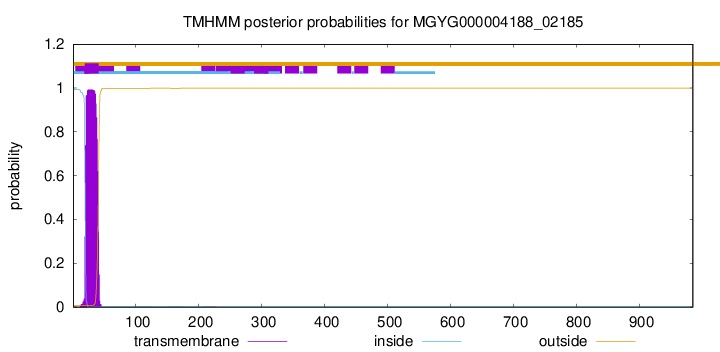You are browsing environment: HUMAN GUT
CAZyme Information: MGYG000004188_02185
You are here: Home > Sequence: MGYG000004188_02185
Basic Information |
Genomic context |
Full Sequence |
Enzyme annotations |
CAZy signature domains |
CDD domains |
CAZyme hits |
PDB hits |
Swiss-Prot hits |
SignalP and Lipop annotations |
TMHMM annotations
Basic Information help
| Species | ||||||||||||
|---|---|---|---|---|---|---|---|---|---|---|---|---|
| Lineage | Bacteria; Bacteroidota; Bacteroidia; Bacteroidales; Bacteroidaceae; Bacteroides; | |||||||||||
| CAZyme ID | MGYG000004188_02185 | |||||||||||
| CAZy Family | PL35 | |||||||||||
| CAZyme Description | hypothetical protein | |||||||||||
| CAZyme Property |
|
|||||||||||
| Genome Property |
|
|||||||||||
| Gene Location | Start: 42318; End: 45275 Strand: + | |||||||||||
CAZyme Signature Domains help
| Family | Start | End | Evalue | family coverage |
|---|---|---|---|---|
| PL35 | 403 | 574 | 9.7e-60 | 0.9776536312849162 |
CDD Domains download full data without filtering help
| Cdd ID | Domain | E-Value | qStart | qEnd | sStart | sEnd | Domain Description |
|---|---|---|---|---|---|---|---|
| pfam00149 | Metallophos | 4.25e-13 | 735 | 935 | 3 | 191 | Calcineurin-like phosphoesterase. This family includes a diverse range of phosphoesterases, including protein phosphoserine phosphatases, nucleotidases, sphingomyelin phosphodiesterases and 2'-3' cAMP phosphodiesterases as well as nucleases such as bacterial SbcD or yeast MRE11. The most conserved regions in this superfamily centre around the metal chelating residues. |
| cd07378 | MPP_ACP5 | 1.12e-08 | 796 | 941 | 75 | 225 | Homo sapiens acid phosphatase 5 and related proteins, metallophosphatase domain. Acid phosphatase 5 (ACP5) removes the mannose 6-phosphate recognition marker from lysosomal proteins. The exact site of dephosphorylation is not clear. Evidence suggests dephosphorylation may take place in a prelysosomal compartment as well as in the lysosome. ACP5 belongs to the metallophosphatase (MPP) superfamily. MPPs are functionally diverse, but all share a conserved domain with an active site consisting of two metal ions (usually manganese, iron, or zinc) coordinated with octahedral geometry by a cage of histidine, aspartate, and asparagine residues. The MPP superfamily includes: Mre11/SbcD-like exonucleases, Dbr1-like RNA lariat debranching enzymes, YfcE-like phosphodiesterases, purple acid phosphatases (PAPs), YbbF-like UDP-2,3-diacylglucosamine hydrolases, and acid sphingomyelinases (ASMases). The conserved domain is a double beta-sheet sandwich with a di-metal active site made up of residues located at the C-terminal side of the sheets. This domain is thought to allow for productive metal coordination. |
| COG1409 | CpdA | 1.20e-08 | 766 | 934 | 40 | 192 | 3',5'-cyclic AMP phosphodiesterase CpdA [Signal transduction mechanisms]. |
| cd07402 | MPP_GpdQ | 6.74e-07 | 795 | 936 | 69 | 195 | Enterobacter aerogenes GpdQ and related proteins, metallophosphatase domain. GpdQ (glycerophosphodiesterase Q, also known as Rv0805 in Mycobacterium tuberculosis) is a binuclear metallophosphoesterase from Enterobacter aerogenes that catalyzes the hydrolysis of mono-, di-, and triester substrates, including some organophosphate pesticides and products of the degradation of nerve agents. The GpdQ homolog, Rv0805, has 2',3'-cyclic nucleotide phosphodiesterase activity. GpdQ and Rv0805 belong to the metallophosphatase (MPP) superfamily. MPPs are functionally diverse, but all share a conserved domain with an active site consisting of two metal ions (usually manganese, iron, or zinc) coordinated with octahedral geometry by a cage of histidine, aspartate, and asparagine residues. The MPP superfamily includes: Mre11/SbcD-like exonucleases, Dbr1-like RNA lariat debranching enzymes, YfcE-like phosphodiesterases, purple acid phosphatases (PAPs), YbbF-like UDP-2,3-diacylglucosamine hydrolases, and acid sphingomyelinases (ASMases). The conserved domain is a double beta-sheet sandwich with a di-metal active site made up of residues located at the C-terminal side of the sheets. This domain is thought to allow for productive metal coordination. |
| PLN02533 | PLN02533 | 3.09e-06 | 687 | 935 | 110 | 334 | probable purple acid phosphatase |
CAZyme Hits help
| Hit ID | E-Value | Query Start | Query End | Hit Start | Hit End |
|---|---|---|---|---|---|
| QRP59764.1 | 2.90e-283 | 39 | 619 | 18 | 598 |
| QQT79787.1 | 2.90e-283 | 39 | 619 | 18 | 598 |
| ASM65217.1 | 4.34e-283 | 39 | 619 | 29 | 609 |
| QUU07041.1 | 8.26e-283 | 39 | 619 | 18 | 598 |
| QUT50039.1 | 3.94e-188 | 47 | 617 | 34 | 604 |
Swiss-Prot Hits help
SignalP and Lipop Annotations help
This protein is predicted as SP

| Other | SP_Sec_SPI | LIPO_Sec_SPII | TAT_Tat_SPI | TATLIP_Sec_SPII | PILIN_Sec_SPIII |
|---|---|---|---|---|---|
| 0.029325 | 0.968779 | 0.001023 | 0.000320 | 0.000259 | 0.000274 |

